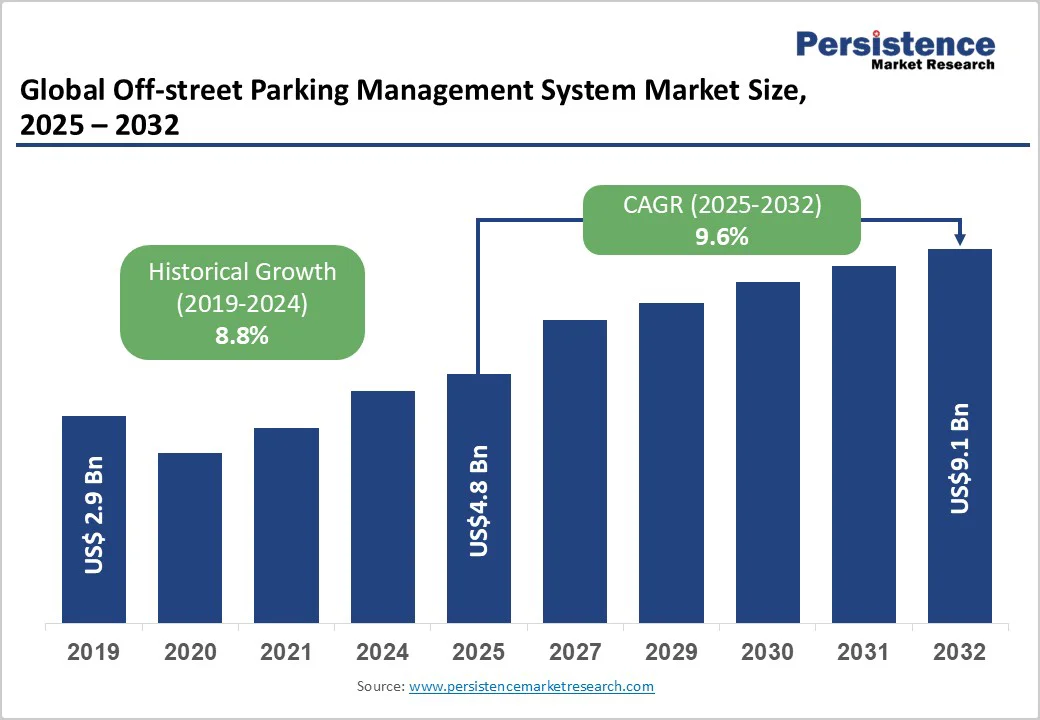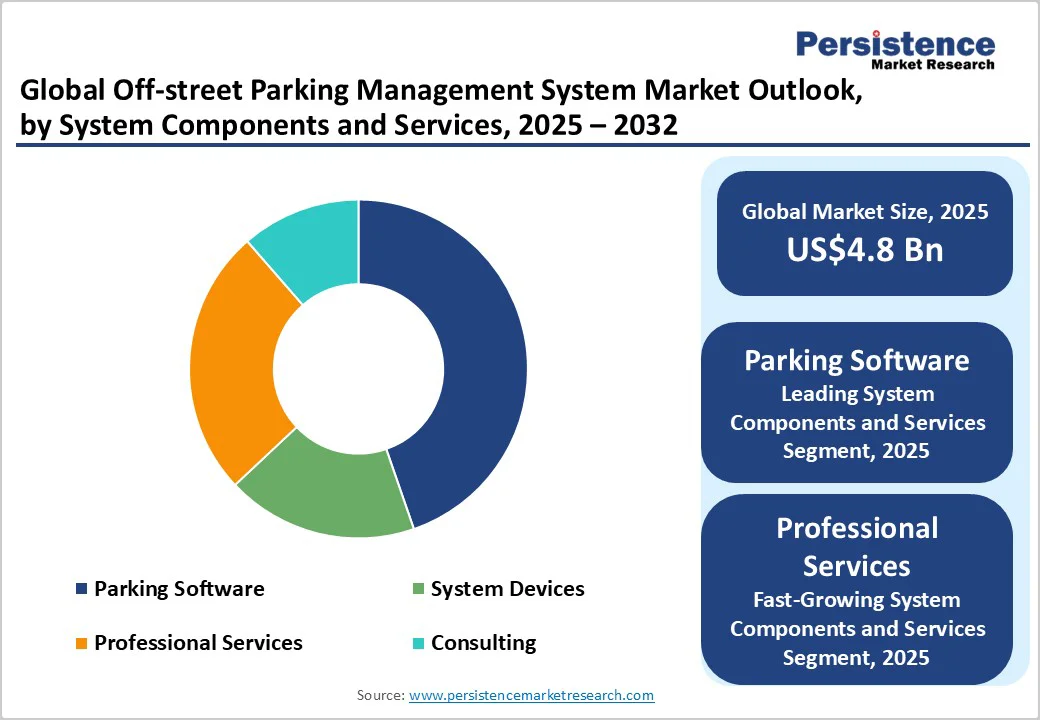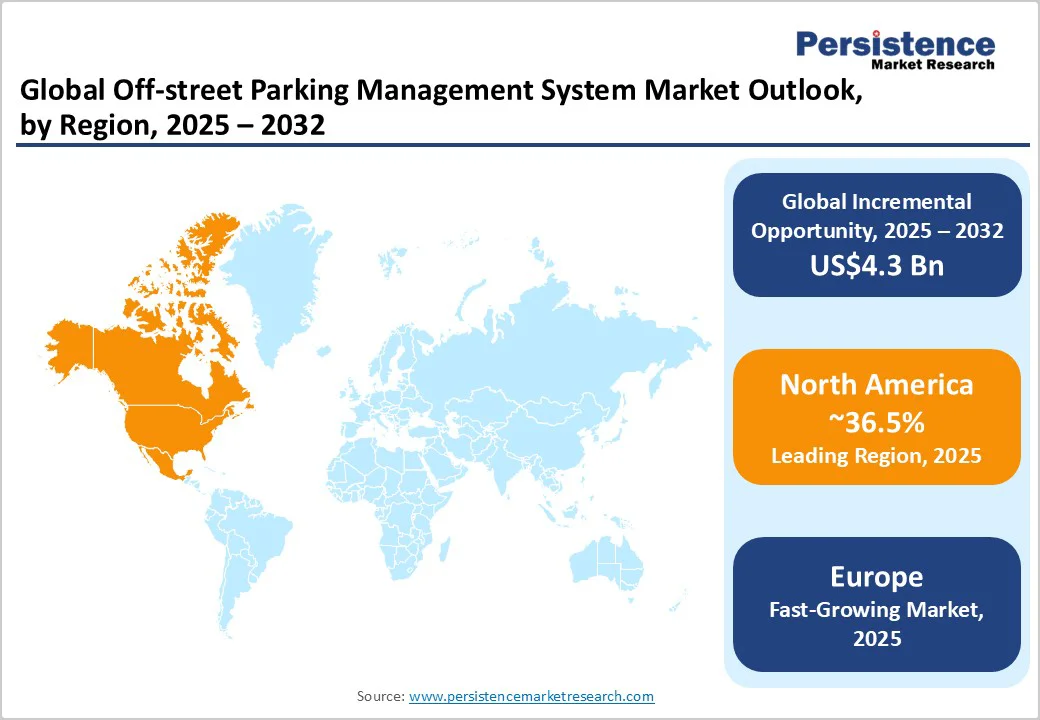ID: PMRREP4728| 190 Pages | 5 Nov 2025 | Format: PDF, Excel, PPT* | Semiconductor Electronics

The global off-street parking management system market size is likely to be valued at US$4.8 Billion in 2025 and is estimated to reach US$9.1 Billion in 2032, growing at a CAGR of 9.6% during the forecast period 2025 - 2032, driven by increasing traffic congestion and rising vehicle ownership. The surging demand for efficient space utilization for parking is also influencing growth.
| Key Insights | Details |
|---|---|
| Off-street Parking Management System Market Size (2025E) | US$4.8 Bn |
| Market Value Forecast (2032F) | US$9.1 Bn |
| Projected Growth (CAGR 2025 to 2032) | 9.6% |
| Historical Market Growth (CAGR 2019 to 2024) | 8.8% |

The rapid rise in urban traffic congestion is a major driver for off-street parking management systems. As cities become more densely populated, on-street parking becomes scarce, creating the requirement for efficient off-street solutions that optimize available space. Smart parking systems, equipped with real-time monitoring, automated ticketing, and digital guidance, help reduce congestion by guiding drivers to vacant spots quickly.
For example, Barcelona’s smart parking initiative uses sensors and mobile apps to direct drivers, reducing traffic delays and emissions. Such technologies not only improve convenience for commuters but also refine urban mobility and environmental sustainability. These make cities more livable and encourage the wide adoption of novel parking management solutions.
The steady increase in the number of vehicles on the road is propelling demand for organized off-street parking systems. Rising vehicle ownership in urban and semi-urban areas has created pressure on existing parking infrastructure, prompting businesses, malls, airports, and municipal authorities to invest in smart parking solutions.
For instance, Singapore has expanded automated parking facilities that use robotic systems to park and retrieve vehicles efficiently, maximizing limited space. Off-street parking management systems reduce manual intervention, minimize vehicle search times, and improve safety, catering to the surging base of private car owners.
High initial investments and ongoing maintenance expenses remain a key restraint for off-street parking management systems. Installing new solutions such as automated barriers, sensors, ticketing machines, and software platforms requires substantial capital outlay. Beyond installation, regular maintenance, software updates, and equipment replacements add to operational costs, which can be a challenge for small municipalities with limited budgets.
For example, implementing a fully automated parking system in a mid-sized city in India can strain local resources, despite its efficiency benefits. These high costs can slow adoption, especially in emerging markets where funding for smart infrastructure projects is limited.
The reliance on technology in off-street parking systems makes them vulnerable to malfunctions and breakdowns, which can disrupt operations and frustrate users. Sensor failures, software glitches, or network outages tend to lead to inaccurate space availability information, payment processing issues, or security lapses.
For instance, a smart parking facility in Singapore experienced temporary downtime due to a software bug, causing confusion among drivers and exhibiting the challenges of system reliability. Such risks require backup procedures and novel technical support, which increase operational complexity.
The integration of cloud-based platforms and automated parking systems presents significant growth opportunities for off-street parking management. Cloud technology enables operators to monitor multiple parking facilities in real time, optimize space allocation, and analyze usage patterns for better decision-making.
Automation, such as robotic parking systems and sensor-driven guidance, increases efficiency by reducing human intervention and minimizing vehicle search time. For example, Spain’s Smart Parking Barcelona project uses cloud-connected sensors to direct drivers to available spaces, thereby reducing congestion and emissions.
The rise of mobile apps for parking reservations and contactless payments delivers substantial growth potential in off-street parking management. Drivers can book parking spots in advance, make secure payments via smartphones, and receive real-time availability updates, improving convenience and reducing wait times.
Companies such as ParkMobile in the U.S. and JustPark in the U.K. have successfully embraced app-based solutions to streamline parking experiences, integrating features such as automated reminders and loyalty programs. Contactless payment systems also improve hygiene and safety, which became a key concern during the COVID-19 pandemic.
Parking software is expected to record a share of nearly 44.7% in 2025, as it centralizes multiple functions, including reservation, payment, access control, and occupancy tracking, into a single platform. It enables ticketless entry, app-based booking, and real-time space availability, which improving convenience for drivers and reducing operational costs for operators.
For example, SpotHero in the U.S. allows users to reserve off-street spaces across 300+ cities. APCOA in Europe also integrates mobile payments, dynamic pricing, and occupancy monitoring to improve garage utilization.
Professional services are seeing traction because operators require expertise to implement, maintain, and optimize these complex systems. Services such as installation, software integration, analytics, and compliance consulting help ensure smooth operations and better ROI. In Asia Pacific, companies such as Park+ provide not only software but also advisory services for smart parking deployment across multiple cities.
Access control is poised to account for approximately 40.2% of the share in 2025, as it ensures security, regulates entry and exit, and minimizes unauthorized use. Novel systems such as License Plate Recognition (LPR) and automated barriers allow smooth and ticketless access while reducing congestion.
For example, Metropolis Technologies in North America uses AI-based LPR across multiple garages to refine vehicle flow and security, showing how access control directly improves operational efficiency.
The parking fee and revenue management segment is witnessing steady growth as it maximizes profitability and ensures accurate financial tracking. Dynamic pricing, digital payment integration, and real-time reporting allow operators to adjust rates based on demand and occupancy.
SpotHero in the U.S. combines reservation-based pricing with automated payments. It enables operators to increase use and revenue while providing drivers with transparent payment options.
Corporate and commercial parks are speculated to hold around 38.5% of the share in 2025 as they have high, predictable daily vehicle traffic and require efficient management to avoid congestion. Companies and business complexes prefer integrated parking solutions with app-based reservations, automated access, and real-time monitoring to ensure smooth employee and visitor flow.
For example, in Singapore, CapitaLand’s commercial campuses use smart parking systems that combine LPR, occupancy sensors, and mobile payment to optimize space usage and reduce peak-hour congestion.
Tourist destinations are estimated to be the fastest-growing segment, as they experience fluctuating, seasonal traffic that demands flexible parking management. Off-street systems at airports, museums, and theme parks help manage peak crowds, improve visitor experience, and generate revenue through dynamic pricing.
A recent example is the Louvre Museum in Paris, which upgraded its off-street parking with automated entry, online reservations, and mobile payments to efficiently handle surges during tourist seasons.

In 2025, North America is predicted to account for approximately 36.5%. The regional market is defined by the ongoing digitization of legacy garages and lots. Operators are prioritizing retrofit projects such as LPR cameras, cloud back-ends, and mobile payments to turn old infrastructure into revenue streams and mobility hubs.
That push is driven by big-city requirements for better curb or lot utilization and by large private operators chasing high yields with reservations and dynamic pricing.
The U.S. off-street parking management system market has also seen major consolidation. Metropolis Technologies’ merger with SP Plus created the largest parking operator in North America, combining AI-based computer vision with a huge real estate footprint.
Similarly, AirGarage has expanded by managing hundreds of lots and garages for real estate firms such as Hines and Greystar. The company is focusing on technology-enabled operations instead of heavy physical infrastructure.
In Europe, the off-street parking management system is being influenced by strict urban policies. Many cities are deliberately cutting on-street parking and compelling drivers into structured garages or underground facilities. For example, Rotterdam removed thousands of on-street spaces and lowered off-street fees to encourage drivers to park in garages instead of city streets.
Regulations are also stringent in the region. The European Commission has introduced common standards for safe and secure parking areas, requiring technology such as license plate recognition and strict security protocols. In France, new rules limit the number of parking spots that can be built with residential projects, especially near public transport, to reduce dependence on private cars.
In Asia Pacific, off-street parking systems are becoming digital and automated, propelled by ongoing urbanization and smart city projects. Several cities are moving toward ticketless entry and exit using license plate recognition, mobile payments, and real-time monitoring. For example, Bengaluru’s KR Market is getting a hi-tech parking hub with AI-enabled CCTV and ticketless access, showing how even aging city spaces are being modernized.
Governments are also stepping in with funding and policy support. In India, Meghalaya launched a grant scheme to encourage private players to build off-street parking infrastructure, including automated systems. Kanpur is rolling out new sites with digital monitoring, instant fines for no-parking violations, and real-time capacity displays, which link enforcement directly to management systems.

The global off-street parking management system market consists of several traditional hardware vendors, software-first start-ups, and large mobility platforms. Hardware providers mainly focus on gates, kiosks, and pay stations, while SaaS-based companies compete by delivering cloud platforms, mobile apps, and digital payments.
Large-scale players strive to bundle hardware and software into one integrated system to make themselves more attractive to airports, malls, and city authorities.
The off-street parking management system market is projected to reach US$4.8 Billion in 2025.
Rising urban traffic and increasing vehicle ownership are the key market drivers.
The off-street parking management system market is poised to witness a CAGR of 9.6% from 2025 to 2032.
Adoption of automated parking and integration of IoT sensors are the key market opportunities.
Cubic Corporation, 3M Co., and Nortech Control Systems Limited are a few key market players.
| Report Attribute | Details |
|---|---|
| Historical Data/Actuals | 2019 - 2024 |
| Forecast Period | 2025 - 2032 |
| Market Analysis | Value: US$ Bn |
| Geographical Coverage |
|
| Segmental Coverage |
|
| Competitive Analysis |
|
| Report Highlights |
|
By System Components and Services
By Solution
By End-user
By Region
Delivery Timelines
For more information on this report and its delivery timelines please get in touch with our sales team.
About Author